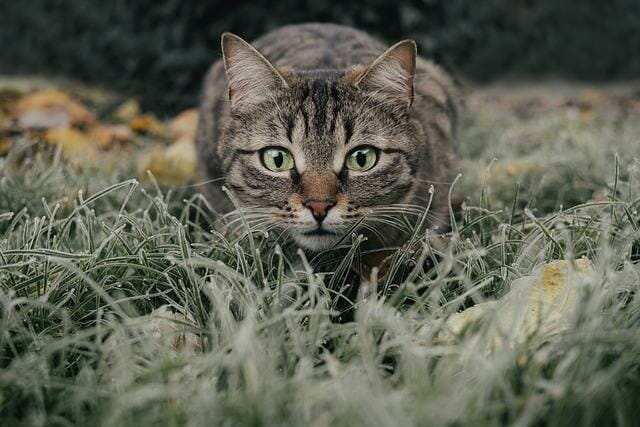Where Do Cats Spray From? Understanding the Motivations of Cats for Spraying
Cats spray urine from their anal glands, located just inside their rectum. When a cat sprays, they release a small amount of urine and pheromones to mark its territory or communicate with other cats.
Male cats are more likely to spray than female cats, which is more common in cats that have not been spayed or neutered. Therefore, if your cat is spraying inside your home, it’s important to address the issue promptly to prevent damage to your furniture and to maintain a healthy and clean living environment.


Table of Contents
Reasons Cats Spray
Territorial Marking
Cats are territorial animals with a strong instinct to mark their territory. Territory marking allows cats to communicate with other cats and establish boundaries. By spraying, cats leave a scent marker that other cats can detect through their sense of smell.
When cats spray, they release a small amount of urine, often on vertical surfaces like walls or furniture. The urine contains chemicals called pheromones, unique to each cat, and can convey information about the cat’s age, sex, and health status.
Territorial marking through spraying is particularly common in male cats, especially if they have not been neutered. Unneutered male cats have higher testosterone levels, which can lead to increased territorial behavior, including spraying. However, female cats and neutered males can also engage in territorial marking through spraying.
Cats may spray to mark their territory for a variety of reasons. For example, they may spray to define the boundaries of their territory, to let other cats know that they are in the area, or to warn other cats to stay away. In multi-cat households, spraying can be a way for cats to establish social hierarchy and dominance over other cats.
Sexual Behavior
Cats may spray as a form of sexual behavior, particularly when they are intact and not neutered. This behavior is more commonly seen in male cats, but female cats can also spray when in heat.
When a male cat is ready to mate, he may spray to advertise his presence to female cats. Spraying releases pheromones that can attract female cats and signal them that he is available for mating. In some cases, male cats may also spray to intimidate other males and establish dominance.
Female cats in heat may also spray as a way of attracting males. When a female cat is in heat, she will release pheromones that male cats from a distance can detect. However, if a male cat does not respond to her scent, she may spray to increase her chances of attracting a mate.
Anxiety or Stress
Cats may spray due to anxiety or stress to mark their territory and create a sense of security in their environment. When a cat feels anxious or stressed, it may spray to establish its presence and create a familiar scent that makes them feel more comfortable.


Some common sources of stress and anxiety for cats include changes in their environment, such as moving to a new home or introducing new pets or people, as well as changes in their routines. For example, when a cat experiences stress or anxiety, it may become more territorial. However, it may resort to spraying to establish its dominance and create a sense of security.
Sometimes, cats may spray to communicate their emotional state to their owners. For example, if a cat feels anxious or stressed, it may spray in areas where its owner spends much time communicating their distress.
If your cat is spraying due to anxiety or stress, provide your cat with a secure and familiar environment, such as a designated sleeping area or a favorite toy, and create a routine that includes regular feeding, playtime, and affection. You can also consider using pheromone sprays or diffusers, which release calming scents to help reduce anxiety and stress in cats.
Medical Issues
Cats may spray due to medical issues such as urinary tract infections (UTIs), bladder stones, or other health problems that affect their urinary tract. For example, when a cat has a medical issue affecting its urinary system, it may feel discomfort or pain when urinating and develop a habit of spraying to relieve it.
UTIs are a common medical cause of spraying in cats. These infections occur when bacteria enter the urinary tract and cause inflammation and irritation. Cats with UTIs may experience pain or discomfort when urinating and associate the litter box with this pain. As a result, they may avoid using the litter box and instead choose to spray to relieve their discomfort.
Bladder stones are another medical condition that can cause spraying in cats. These stones are hard mineral deposits in the bladder and can cause pain and discomfort when urinating. In addition, cats with bladder stones may develop a habit of spraying to relieve their discomfort. They may also experience other symptoms, such as frequent urination or blood in the urine.
Other medical issues that can cause cat spraying to include kidney disease, diabetes, and hyperthyroidism. These conditions can affect the cat’s urinary system and increase urination and spraying behavior.
Social Hierarchy


Cats may spray for social hierarchy to establish dominance and maintain their social rank within a group of cats. This behavior is common in multi-cat households, where cats compete for food, water, or sleeping areas.
When cats spray for social hierarchy, they essentially mark their territory and communicate their status to other cats. By spraying, a cat leaves a scent marker that other cats can detect through their sense of smell. This scent marker contains information about the cat’s age, sex, and health status, which can convey information about their social rank within the group.
Cats lower in the social hierarchy may be more likely to spray to assert their dominance and compete with higher-ranking cats for resources. However, even higher cats in the social hierarchy may spray to maintain their status and communicate their dominance to other cats.
It’s important to note that spraying for the social hierarchy is normal for cats and is not necessarily a sign of a problem. However, if the spraying behavior becomes excessive or causes conflicts among the cats, it may be necessary to take steps to reduce the behavior.
This can include providing each cat with resources, such as food bowls and litter boxes, and creating separate sleeping areas to reduce competition and conflicts among the cats. Additionally, behavior modification techniques, such as positive reinforcement training, may help reduce spraying behavior and promote peaceful cat interactions.
